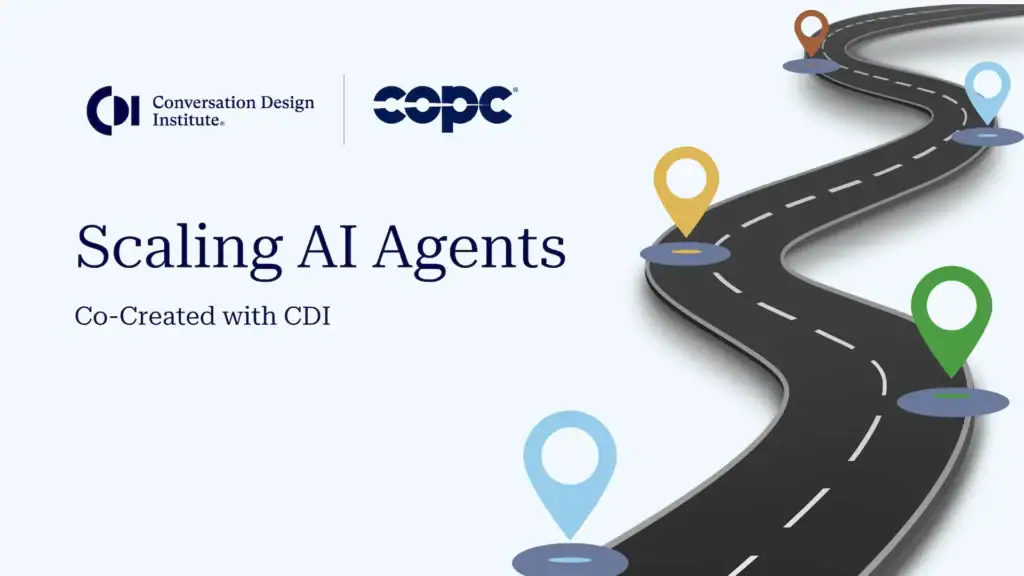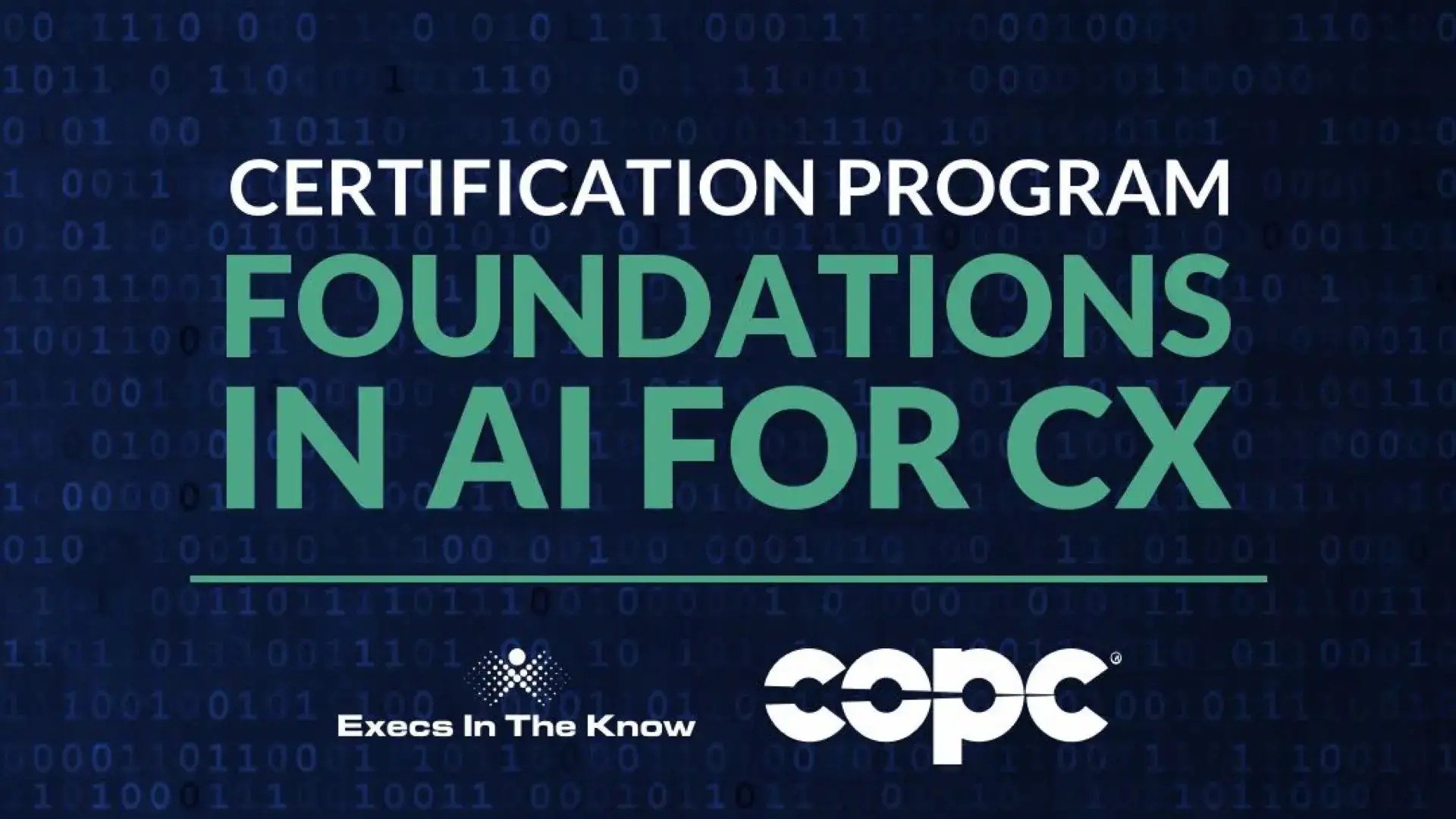
August 17, 2025
The pressure to “do something with AI” has reached every corner of the CX world. In customer experience, that leads to rushed projects, unrealistic expectations, and tools that go live without a clear connection to any business impact. That’s the wrong way to build.
In a recent collaboration between COPC Inc. and the Conversation Design Institute (CDI), industry leaders outlined a practical framework for scaling AI in a way that’s both functional and ready for the future. The takeaway is that success doesn’t come from excitement alone. It comes from a structured approach that leads with good design, alignment, and planning.
CDI and COPC revealed the 6 Pillars framework that leads to intentional AI implementation in a joint webinar. This webinar was a preview to a 4-part course which is now available, Scaling AI Agents from a CX Perspective.
“Excitement is a necessary ingredient for success, but it’s not enough. Scaling tall and wide means proper planning to avoid post-launch panic.”
—Jeff Tropeano, EVP, COPC Inc.
Here’s how to apply the six foundational pillars of AI scaling to ensure your CX transformation is meaningful and measurable.
1. Vision: Anchor Your AI Strategy in Customer and Brand Outcomes
The most common mistake in AI implementations is starting with the technology and working backward. The most effective programs start with a clear articulation of what success looks like and why the organization is pursuing AI in the first place.
An intentional CX technology strategy doesn’t happen by accident. Successful organizations use a journey-first design approach.
Whether the goal is to increase availability, reduce effort, or personalize experiences, your AI should reinforce your brand values and customer promises.
We start with questions like: What are we trying to improve? Are we reducing effort? Increasing containment? Improving experience? Every other decision, including technology, governance, and data, needs to support that outcome.
“Don’t automate for automation’s sake. Automate to enhance an experience that already reflects the values of your brand.”
—Jeff Tropeano, COPC
If your company is known for warmth and empathy, your bots should reflect that tone—or escalate quickly to a human. If you’re all about speed and efficiency, focus on reducing friction in the customer journey. Vision isn’t just a nice-to-have—it’s the lens that informs every decision.
2. People: Bring Your Team Into the Process Early
AI may be a technology initiative, but its success begins and ends with your people.
Agents, supervisors, QA leaders, and trainers will often be deeply impacted by the introduction of conversational AI. Too often, they’re brought in late or not at all.
“Put your tech team at the center. Acknowledge their concerns, give them time to learn, and empower them to lead on risk mitigation.”
—Rachel Whitehorn, Conversational AI Practice Lead, CDI
Start with empathy. Get ahead of fear by inviting your teams to shape how AI is implemented. Agents can become bot trainers. QA specialists may evolve into prompt engineers. Supervisors may start managing both human and digital agents.
“Most AI experiences today are still just ‘people simulations.’ Don’t design around your team—design with them.”
—Jeff Tropeano, COPC
3. Risks: Plan for What Can—and Will—Go Wrong
People worry about hallucinations and off-brand outputs, and they should. But there are other risks too: exposing PII, training bias, or buying from vendors who’ve scraped IP without consent. AI brings real legal and ethical exposure.
That’s why risk planning must go beyond compliance checklists. It should include:
- Guardrails for what bots can and cannot say
- Clear escalation paths to human agents
- Ownership for AI performance monitoring
And don’t forget ethical risks—such as model bias, sustainability, or misuse of data. You can’t outsource ethics to your vendor. You need to define where your organization stands.
“Even if your country isn’t mandating regulation, follow a standard you’d be proud to defend. Don’t wait to be told—decide where your company stands.”
—Rachel Whitehorn, CDI
4. Use Cases: Choose for the Customer, Not Just the Business
Choosing the right use cases is one of the most strategic decisions in your AI journey. Many organizations start with internal pain points—low-value tasks they want to automate. But true value lies in what customers care about most.
Avoid the temptation of delegating the organization’s headaches onto the customer. The organization should empower the customer. The customer is not a dumping ground for internal inefficiencies. If they are forced to repeat themselves, navigate disjointed channels, or compensate for your broken processes, that’s not innovation—it’s abdication.
The ideal use cases are:
- High frequency
- Relatively simple
- Valuable to automate from both a CX and operational perspective
“It’s not about designing just what’s supposed to happen. You have to plan for when things go off trail—and how to get the customer back on track.”
—Rachel Whitehorn, CDI
Go beyond FAQs. Focus on actions. Customers don’t need bots that explain a problem. They need bots that solve it.
“Customers don’t want a bot that understands the problem. They want one that solves it.”
—Jeff Tropeano, COPC
5. Metrics: Predict the Impact—Don’t Just Measure it Later
If you’re only thinking about metrics at go-live, you’re already behind.
Set clear hypotheses before implementation. Define the KPIs that matter most—containment rate, resolution time, CSAT, error rates—and predict how they’ll shift.
“Don’t shoot the arrow first and draw a target around it where it lands. Reverse that. Define the target up front—then shoot toward it.”
—Jeff Tropeano, COPC
And remember: It’s not just about whether the bot completed a transaction. Ask: Did it improve the journey? Did the solution persist after the interaction? Was the customer actually satisfied?
6. Technology: Build a Foundation That Supports Scale—Not Just Speed
Selecting the right tech stack is critical—but it’s not about the flashiest AI or the biggest vendor. It’s about choosing tools that fit your use cases, data ecosystem, and long-term roadmap.
“The method of sourcing technology is going to change. Traditional RFP cycles are too slow for the pace of innovation.”
—Jeff Tropeano, COPC
Make sure your platforms support:
- Integration with core systems
- Access to structured and unstructured data
- Governance and observability
- Flexibility to support both deterministic and generative models
And perhaps most importantly, clean up your data. No platform—no matter how advanced—can save you from “garbage in, garbage out.”
Final Thought: Scale Starts With Strategy
AI agents aren’t just another channel. Done right, they reshape how your business engages, solves problems, and scales service.
But to move beyond small pilots and drive lasting impact, you can’t start with hype. You need vision, alignment, guardrails, and infrastructure that’s built to scale.
“People think about scale at the end—after a pilot works. But scaling happens at the beginning. It starts in your mindset.”
—Rachel Whitehorn, CDI
This 6 Pillars framework is your blueprint. Use it not only to plan—but to lead.
To dive even deeper, COPC and CDI created a 4-part course beginning Aug. 13, 2025, which you can access via the CDI Academy Learning Platform. With an annual subscription, you will have access to all four modules plus all of CDI’s course materials.
- Scaling AI and Avoiding Common Pitfalls
- The Six Pillars of AI Planning: Vision, Risk and Use Cases
- User-Centric AI Design and Human-AI Collaboration
- Continuous Improvement and Standards for Scalable AI

COPC also offers a live, virtual Certification Program: Foundations in AI for CX. Co-developed with Execs In The Know, this program provides a definitive roadmap to transform AI’s potential into actionable solutions.

- Select and manage technology providers.
- Align AI strategies with customer needs and business goals.
- Navigate AI governance and ethics.
- Prepare and manage knowledge bases.
- Avoid costly missteps with metrics to manage and improve performance.